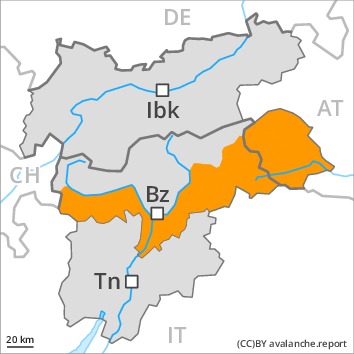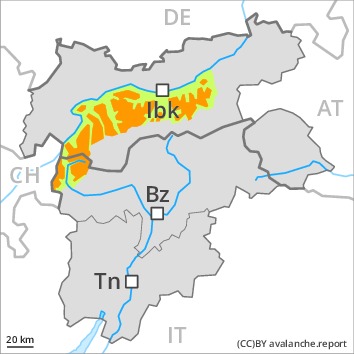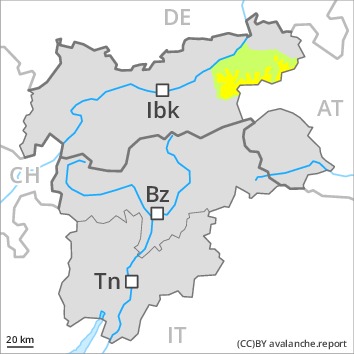
Danger level
Avalanche Problem

A precarious avalanche situation will prevail. Fresh and older wind slabs are to be critically assessed.
As a consequence of new snow and a strong wind from southeasterly directions, avalanche prone wind slabs will form in all aspects, caution is to be exercised on steep slopes also below the tree line, in the regions exposed to a lot of wind in particular. The fresh and somewhat older wind slabs can be released easily in all aspects. As a consequence of new snow and strong wind the avalanche prone locations will become more prevalent as the day progresses. Older wind slabs are covered with new snow and therefore difficult to recognise.
In addition the danger of natural avalanches will increase as the day progresses. Mostly the avalanches are medium-sized.
Whumpfing sounds and the formation of shooting cracks when stepping on the snowpack and natural avalanches serve as an alarm indicating the danger. Extensive experience in the assessment of avalanche danger and great restraint are required.
In regions exposed to heavier precipitation the avalanche prone locations are more prevalent and the danger is slightly greater.
Snowpack
dp.6: cold, loose snow and wind
dp.8: surface hoar blanketed with snow
20 to 40 cm of snow, and even more in some localities, will fall until Sunday. The southeasterly wind will transport the fresh and old snow. The new snow and wind slabs will be deposited on the unfavourable surface of an old snowpack in all aspects. The upper section of the snowpack is fairly homogeneous and its surface consists of surface hoar. Towards its base, the snowpack is well consolidated. Stability tests and field observations confirm this situation.
Tendency
A precarious avalanche situation will be encountered over a wide area.

Danger level
 | treeline
|
Avalanche Problem
 | | Wind-drifted snow |
|  | |  |
 | | Wind-drifted snow |
|  | |  |

The current avalanche situation calls for extensive experience and restraint.
On wind-loaded slopes a treacherous avalanche situation will be encountered over a wide area. The fresh and somewhat older wind slabs can be released easily in all aspects. Caution is to be exercised in particular adjacent to ridgelines and in gullies and bowls. Mostly the avalanches are only shallow. The avalanche prone locations are prevalent and are difficult to recognise. In all aspects the avalanche prone locations will become more prevalent as the day progresses.
Snowpack
dp.6: cold, loose snow and wind
dp.8: surface hoar blanketed with snow
10 to 20 cm of snow, and even more in some localities, will fall until Sunday. As a consequence of new snow and a strong wind from southeasterly directions, avalanche prone wind slabs will form in all aspects. The new snow will be deposited on the unfavourable surface of an old snowpack. In some cases new snow and wind slabs are lying on surface hoar. Towards its base, the snowpack is well consolidated. Stability tests and field observations confirm this situation.
Tendency
Fresh wind slabs are to be evaluated with care and prudence. Whumpfing sounds and the formation of shooting cracks when stepping on the snowpack and fresh avalanches serve as an alarm indicating the danger.

Danger level
 | treeline
|
Avalanche Problem
 | | Wind-drifted snow |
|  | |  |
 | | Persistent weak layer |
|  | |  |

Wind slabs are to be evaluated critically.
The fresh and somewhat older wind slabs can be released by a single winter sport participant especially on steep shady slopes above the tree line, caution is to be exercised in particular adjacent to ridgelines and in gullies and bowls. Mostly the avalanches are medium-sized. The number and size of avalanche prone locations will increase with altitude.
Weak layers in the lower part of the snowpack can be released in some places by individual winter sport participants. Caution is to be exercised in particular on steep shady slopes above approximately 2200 m, especially in areas where the snow cover is rather shallow, as well as at transitions from a shallow to a deep snowpack, when entering gullies and bowls for example.
Snowpack
dp.6: cold, loose snow and wind
dp.1: deep persistent weak layer
Some snow will fall in some localities, in particular in the south. Towards its surface, the snowpack is hard. In some places relatively hard layers of snow are lying on soft layers. The wind slabs are lying on surface hoar in some places at intermediate and high altitudes. Snow profiles confirm this situation.
Steep shady slopes: The old snowpack will be prone to triggering in some places. Towards its base, the snowpack consists of faceted crystals.
Tendency
Fresh and older wind slabs require caution.

Danger level
 | treeline
|
Avalanche Problem

Wind slabs require caution.
The fresh and somewhat older wind slabs are in some cases prone to triggering above the tree line, especially adjacent to ridgelines and in gullies and bowls. Mostly avalanches are only small but can be released also by a single winter sport participant. The prevalence of avalanche prone locations and likelihood of triggering will increase with altitude.
Snowpack
dp.6: cold, loose snow and wind
Some snow will fall in some localities, especially in the south. The southeasterly wind will transport the snow. In some places wind slabs are lying on soft layers, especially on shady slopes.
Tendency
The avalanche danger will persist.

Danger level
 | treeline
|
Avalanche Problem
 | | Wind-drifted snow |
|  | |  |
 | | Persistent weak layer |
|  | |  |

Wind slabs and weakly bonded old snow require caution.
Wind slabs can be released especially on steep shady slopes above the tree line, caution is to be exercised in particular adjacent to ridgelines and in gullies and bowls. The avalanches are rather small. The number and size of avalanche prone locations will increase with altitude.
Weak layers in the lower part of the snowpack can be released in some places by individual winter sport participants. Caution is to be exercised in particular on steep shady slopes above approximately 2200 m, especially in areas where the snow cover is rather shallow, as well as at transitions from a shallow to a deep snowpack, when entering gullies and bowls for example.
Snowpack
dp.6: cold, loose snow and wind
dp.1: deep persistent weak layer
Some snow will fall in some localities, in particular in the south. Towards its surface, the snowpack is hard. In some places relatively hard layers of snow are lying on soft layers. This applies in particular above the tree line.
Steep shady slopes: The old snowpack will be prone to triggering in some places. Towards its base, the snowpack consists of faceted crystals.
Tendency
Fresh and older wind slabs require caution.

Danger level

Low, level 1.
Wind slabs require caution. This applies on very steep shady slopes, and adjacent to ridgelines above approximately 2000 m. The avalanche prone locations are rare and are easy to recognise.
Snowpack
dp.6: cold, loose snow and wind
In some places wind slabs are lying on soft layers, especially on shady slopes at elevated altitudes. From a snow sport perspective, in most cases insufficient snow is lying.
Tendency
Low, level 1.



















